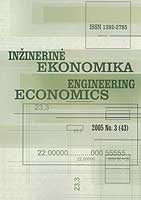The Model of Organization Performance Comprising the Relationships with Stakeholders from the Aspect of Total Quality Management
The Model of Organization Performance Comprising the Relationships with Stakeholders from the Aspect of Total Quality Management
Author(s): Algirdas Jurkauskas, Dalia SUSNIENĖSubject(s): Economy
Published by: Kauno Technologijos Universitetas
Keywords: stakeholders; harmonization of needs; satisfaction of interests; total quality management; organization processes and model.
Summary/Abstract: Cooperation with stakeholders is the key attribute of organizations having no boundaries and open to innovations. In order to be successful in a very competitive and unstable environment companies must have ‘pervious’ boundaries and be open to information, ideas and people. This will enable to see the straight direction for the fast and effective performance. Such ‘boundarless’ organizations are very dependant on relationships. How should such an organization look like? Firstly, top managers establish conditions and secure relationships nurturing such values as reciprocity and trust. Secondly, open and fair interrelation is promoted together with minimization of red-tape whereas employees’ participation in inter-functional or cross-functional groups is understood as a part of daily work. The groups are set up of different organizational levels and departments. They identify and mobilize resources and liaise with organization. Authorization of taking a decision is delegated into the hands of people that are directly related with this activity. Thirdly, employees present ideas on how to increase efficiency of organization performance. The presented model in this research highlights not only internal processes but also the measurement of all pack of processes that corresponds balanced-scorecard theory. Processes describe the numerous connections that cut across the organization, the interaction of staff and departmental activity and the flow of work that actually occurs, to ultimately deliver stakeholder satisfaction. The model includes both proactive and reactive improvement elements where qualitative and quantitative indicators are used. Successful implementation of total quality management depends on infrastructure, i.e. on organizations promoting total quality management, legal environment, scientific research, establishment of new methods, dissemination of information, practical training, etc.
Journal: Engineering Economics
- Issue Year: 2006
- Issue No: 1 (46)
- Page Range: 20-26
- Page Count: 7
- Language: English

